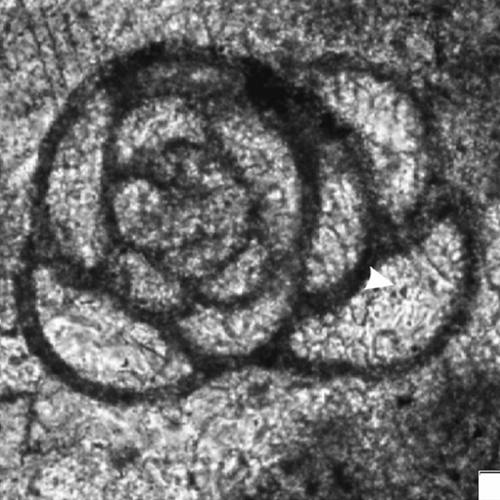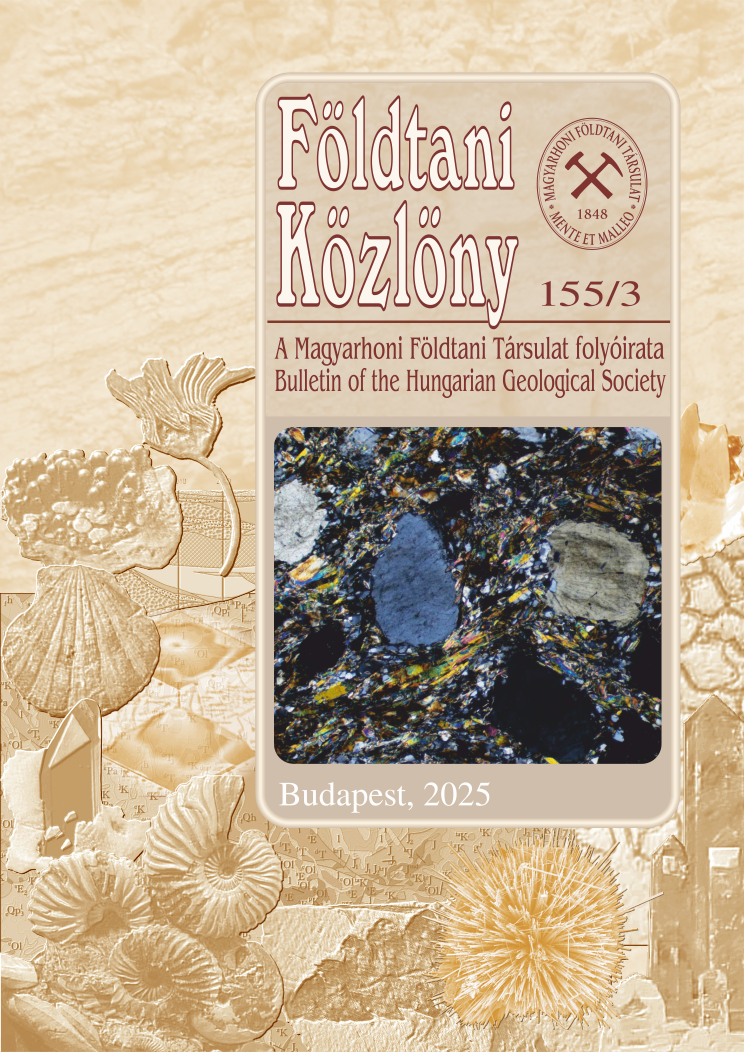“Oasis in the desert” — a particularly rich fossil assemblage from the fossil-poor Szeged Dolomite Formation, Üllés (Szeged Basin, Hungary)
Abstract
The dark grey, brecciated dolomite, which is classified in the Szeged Dolomite Formation, is the most characteristic Mesozoic formation in the Szeged Basin. The representative feature of the formation is the pervasive dolomitization and recrystallization, which accounts for the poor preservation and low specimen number of fossils. This work is a report on the results of a study of an exceptionally rich and well-preserved fossil assemblage. In the thin sections of the Üllés–18 well (Core #6), besides a Hoyenella–Glomospirella–Glomospira-dominated foraminifer assemblage, algae colonies and ostracod double shells were also observed. The special nature of the sample was given by a juvenile specimen of a Megalodontidae (Bivalvia). The carbonate microfacies and fossil assemblage indicate Middle Triassic (Upper Anisian – Ladinian), shallow, backreef-lagoon environments and waters of elevated salinity during the deposition. This high salinity seawater could have played a role in the near-surface dolomitization of the formation.
References
BÉRCZINÉ MAKK A. 1985: Mesozoic formation types of the Great Hungarian Plain. — Általános Földtani Szemle 21, 3–47.
BÉRCZINÉ MAKK, A. 1986: Mesozoic formation types of the Great Hungarian Plain. — Acta Geologica Hungarica 29/3–4, 261–282.
BÉRCZINÉ MAKK, A. 1996: Foraminifera of the Triassic formations of Alsó Hill (Northern Hungary). Part 2: Foraminifera assemblage of the Wetterstein Limestone Formation. — Acta Geologica Hungarica 39/3, 223–309.
BÉRCZINÉ MAKK, A., KONRÁD, GY., RÁLISCHNÉ FELGENHAUER, E. & TÖRÖK, Á. 2004: Tiszai Egység. — In: HAAS J. (ed.): Magyarország geológiája, Triász. — Eötvös Kiadó, Budapest, 303–354.
BLEAHU, M., MANTEA, G., BORDEA, S., PANIN, S., ŞTEFĂNESCU, M., SIKIĆ, K., HAAS, J., KOVÁCS, S., PÉRÓ, CS., BÉRCZI-MAKK, A., KONRÁD, GY., NAGY, E., RÁLISCH-FELGENHAUER, E. & TÖRÖK, Á. 1994: Triassic facies types, evolution and paleogeographic relations of the Tisza Megaunit — Acta Geologica Hungarica 37, 187–234.
GARAGULY, I., RAUCSIK, B., VARGA, A. & SCHUBERT, F. 2017: Középső-triász dolomitok képződésének története és töréses deformációja a Szegedi-medence területén — Földtani Közlöny 147/1, 39–60. https://doi.org/10.23928/foldt.kozl.2017.147.1.39
GAŹDZICKI, A. 1983: Foraminifers and biostratigraphy of Upper Triassic and Lower Jurassic of the Slovakian and Polish Carpathians. — Palaeontologia Polonica 44, 109-169.
HAAS, J. & PÉRÓ, CS. 2004: Mesozoic evolution of the Tisza Mega-unit. — International Journal of Earth Sciences 93, 297–313. https://doi.org/10.1007/s00531-004-0384-9
HAAS, J., BUDAI, T., CSONTOS, L., FODOR, L. & KONRÁD GY. 2010: Magyarország pre-kainozoos földtani térképe, 1:500 000. — Magyar Állami Földtani Intézet kiadványa, Budapest
HORVÁTH A. 1990: Szedimentáció- és diagenezis vizsgálatok D-alföldi szénhidrogénkutató fúrások anizuszi dolomit (Szegedi terület) és nagyharsányi mészkő (Bácskai terület) képződményein. — Doktori értekezés, kézirat, ELTE, Budapest, 107 p.
KEMENCI, R. & ČANOVIĆ, M. 1997: Geologic setting of the Pre-Tertiary basement in Vojvodina (Yugoslavia). Part I: The Tisza Megaunit of North Vojvodina — Acta Geologica Hungarica 40, 1–36.
KOLAR-JURKOVŠEK, T., VUKS, V., ALJINOVIĆ, D., HAUTMANN, M., KIAM, A. & JURKOVŠEK, B. 2013: Olenekian (Early Triassic) fossil assemblage from eastern Julian Alps (Slovenia). — Annales Societatis Geologorum Poloniae 83/3, 213–227. https://doi.org/10.5167/uzh-94540
MACHEL, H. G. 2004: Concepts and models of dolomitization: a critical reappraisal.— In: BRAITHWAITE, C.J.R., RIZZI, G. & DARKE,G. (Eds.) The Geometry and Petrogenesis of Dolomite Hydrocarbon Reservoirs. — Geol. Soc. London Spec. Publ. 235, 7–63. https://doi.org/10.1144/gsl.sp.2004.235.01.01
MAURER, F. & RETTORI, R. 2002: Middle Triassic Foraminifera from the Seceda Core (Dolomites, Northern Italy). — Rivista Italiana di Paleontologia e Stratigrafia 108/3, 391–398. https://doi.org/10.13130/2039-4942/5484
ORAVECZ-SCHAFFER, A. 1987: A Dunántúli-középhegység triász képződményeinek foraminiferái (Triassic Foraminifers of theTransdanubian Central Range) — Geologica Hungarica Series Palaeontologica 50, 1–331.
SALAJ, J., BORZA, K. & SAMUEL, O. 1983: Triassic Foraminifers of the West Carpathians. — Geologický Ústav Dionýza Štúra, 213 p.
T. KOVÁCS G. 1977: A Dél-Alföld mezozoikuma. — Földtani Közlöny 107, 150–167.
VÉGH-NEUBRANDT, E. 1982: Triassische Megalodontaceae: Entwicklung, Stratigraphie und Paläontologie. — Akadémiai Kiadó, Budapest, 526 pp.
VELLEDITS, F., PÉRÓ, CS., BLAU, J., SENOWBARI-DARYAN, B., KOVÁCS, S., PIROS, O., POCSAI, T., DUMITRICA, P. & PÁLFY, J. 2011: The oldest Triassic platform margin reef from the Alpine-Carpathian region (Aggtelek, NE Hungary): Platform evolution, reef albiota and biostratigraphic framework. — Rivista Italiana di Paleontologia e Stratigrafia 117/2, 221–268. https://doi.org/10.13130/2039-4942/5973
ZANINETTI, L. 1976: Les Foraminifères du Trias. — Rivista Italiana di Paleontologia e Stratigrafia 82/1, 1–258.
WARREN, J. K., 2000: Dolomite: occurrence, evolution and economically important associations. — Earth-Science Reviews 52, 1–81. https://doi.org/10.1016/s0012-8252(00)00022-2
















